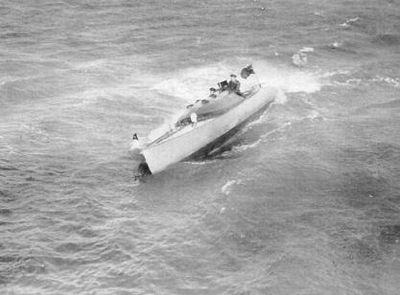
Water motorsports at the 1908 Summer Olympics
Encyclopedia
At the 1908 Summer Olympics
, three motorboat racing
events were contested. Various sources refer to the sport as "water motorsports", "motor boats", and "power boating". These Games were the first and only to feature motorized sports, though it was featured as a demonstration sport in 1900
.
All three events used the same distance, five laps around an 8 nautical mile
course for a total of 40 nautical miles (74.1 km). In each of the events, multiple boats started but only one finished, due primarily to the gale
that was blowing during the course of the competition. Events were held on 28 August and 29 August 1908.
The water motorsports event was quickly abolished due to the fact that after these games the IOC decided that the olympics was not intended for motorized competition.
A second attempt to run the event took place the next day, after the other two races had been completed. Wolseley-Siddely again started, this time against Camille (the only French boat to take part in competition). Wolseley-Siddely ran aground on a mud spit, leaving Camille to finish alone for the gold medal.
FRS, the great Victorian engineer, previously the designer and builder of the world's first torpedo boats and torpedo boat 'Destroyers'. Development of the technical features of Gyrinus (combining speed with good seaworthiness, as demonstrated in the 1908 Olympics) was described in 'Engineering', the Proceedings of the Society of Civil Engineers, on March 12, 1909. His son, Isaac Thomas Thornycroft
, the Gyrinus helmsman, became a yacht designer and helmsman of J Class racing yachts. Thomas's son, Commander Peter Thornycroft (1914–1987), carried on the family tradition, developing the SPMH as the standard Nelson Class of Pilot Boat for Trinity House (1964 to 1987) and, later, up to much larger sizes of offshore patrol vessels. The US Navy's 350 ft./114-metre/3,200-ton/45-knot USS Freedom is the largest SPMH launched to date (2006). It combines a higher speed-for-length than would be possible with a conventional destroyer hull, good seakeeping at speed and a high payload: characteristics that enabled the little Gyrinus to win her famous Olympic victories.

1908 Summer Olympics
The 1908 Summer Olympics, officially the Games of the IV Olympiad, were an international multi-sport event which was held in 1908 in London, England, United Kingdom. These games were originally scheduled to be held in Rome. At the time they were the fifth modern Olympic games...
, three motorboat racing
Offshore powerboat racing
Offshore powerboat racing is racing by large, specially designed ocean-going powerboats, typically point-to-point racing.Probably one of the largest, most dangerous, and most powerful racing machines of all, the extreme expense of the boats and the fuel required to participate make it an expensive...
events were contested. Various sources refer to the sport as "water motorsports", "motor boats", and "power boating". These Games were the first and only to feature motorized sports, though it was featured as a demonstration sport in 1900
1900 Summer Olympics
The 1900 Summer Olympics, today officially known as the Games of the II Olympiad, was an international multi-sport event which was celebrated in 1900 in Paris, France. No opening or closing ceremonies were held; competitions began on May 14 and ended on October 28. The Games were held as part of...
.
All three events used the same distance, five laps around an 8 nautical mile
Nautical mile
The nautical mile is a unit of length that is about one minute of arc of latitude along any meridian, but is approximately one minute of arc of longitude only at the equator...
course for a total of 40 nautical miles (74.1 km). In each of the events, multiple boats started but only one finished, due primarily to the gale
Gale
A gale is a very strong wind. There are conflicting definitions of how strong a wind must be to be considered a gale. The U.S. government's National Weather Service defines a gale as 34–47 knots of sustained surface winds. Forecasters typically issue gale warnings when winds of this strength are...
that was blowing during the course of the competition. Events were held on 28 August and 29 August 1908.
Medal summary
| Class A — Open |
Camille |
none | none |
| Class B — Under 60 feet |
Gyrinus |
none | none |
| Class C — 6.5–8 metres |
Gyrinus |
none | none |
The water motorsports event was quickly abolished due to the fact that after these games the IOC decided that the olympics was not intended for motorized competition.
Medal table
| 1 | 2 | 0 | 0 | 2 | |
| 2 | 1 | 0 | 0 | 1 |
Class A — Open class
The open class was scheduled to take place on the first day of competition, 28 August. Two boats, Wolseley-Siddely and Dylan, began the race. Dylan abandoned the race partway through the first lap, with Wolseley-Siddely finishing the first before the weather became too severe to continue the race.A second attempt to run the event took place the next day, after the other two races had been completed. Wolseley-Siddely again started, this time against Camille (the only French boat to take part in competition). Wolseley-Siddely ran aground on a mud spit, leaving Camille to finish alone for the gold medal.
Class B — Under 60 feet
The B class was held on 28 August, after the abortive first running of the open class. Again only two boats appeared at the starting line, Quicksilver and Gyrinus. Quicksilver became threatened by water coming in over the sides, abandoning the race. Gyrinus, a small boat with an extra crewman to bail water, was able to finish to make its crew the first Olympic champions in motorsports. Gyrinus was the earliest round-bilge Semi-Planing Mono-Hull ('SPMH') designed by Sir John Isaac ThornycroftJohn Isaac Thornycroft
Sir John Isaac Thornycroft was a British shipbuilder, the founder of the Thornycroft shipbuilding company and member of the Thornycroft family.-Biography:He was born in 1843 to Mary Francis and Thomas Thornycroft....
FRS, the great Victorian engineer, previously the designer and builder of the world's first torpedo boats and torpedo boat 'Destroyers'. Development of the technical features of Gyrinus (combining speed with good seaworthiness, as demonstrated in the 1908 Olympics) was described in 'Engineering', the Proceedings of the Society of Civil Engineers, on March 12, 1909. His son, Isaac Thomas Thornycroft
Isaac Thomas Thornycroft
Isaac Thomas "Tom" Thornycroft was a British motorboat racer who competed in the 1908 Summer Olympics.He won two gold medals in the only motor boat competitions included in the Olympics as helmsman of the Gyrinus II, which was designed by his father Sir John Isaac Thornycroft.He became a yacht...
, the Gyrinus helmsman, became a yacht designer and helmsman of J Class racing yachts. Thomas's son, Commander Peter Thornycroft (1914–1987), carried on the family tradition, developing the SPMH as the standard Nelson Class of Pilot Boat for Trinity House (1964 to 1987) and, later, up to much larger sizes of offshore patrol vessels. The US Navy's 350 ft./114-metre/3,200-ton/45-knot USS Freedom is the largest SPMH launched to date (2006). It combines a higher speed-for-length than would be possible with a conventional destroyer hull, good seakeeping at speed and a high payload: characteristics that enabled the little Gyrinus to win her famous Olympic victories.
Class C — 6.5–8 metres
The first race of 29 August was the small class of boats. Gyrinus, which had won the B class the day before, appeared again. This time her competition was Sea Dog. Again, however, Gyrinus was the only boat to finish, as Sea Dog experienced engine problems and had to be towed off the course.Dylan
- Thomas Evelyn Scott-Ellis, 8th Baron Howard de WaldenThomas Scott-Ellis, 8th Baron Howard de WaldenThomas Evelyn Scott-Ellis, 8th Baron Howard de Walden, 4th Baron Seaford , was a British peer, landowner, writer and patron of the arts. He was also a motorboat racer who competed in the 1908 Summer Olympics.-Biography:...
- A. G. Fentiman
Sea Dog
- Warwick Wright
- Thomas Weston
Wolseley-Siddely

- Hugh Grosvenor, 2nd Duke of WestminsterHugh Grosvenor, 2nd Duke of WestminsterHugh Richard Arthur Grosvenor, 2nd Duke of Westminster GCVO DSO was the son of Victor Alexander Grosvenor, Earl Grosvenor and Lady Sibell Mary Lumley, the daughter of the 9th Earl of Scarborough...
- George Clowes
- Joseph Frederick LaycockJoseph Frederick LaycockBrigadier General Sir Joseph Frederick Laycock KCMG, DSO, TD was a British soldier, and Olympic sailor.Laycock was the High Sheriff of Nottinghamshire in 1906....
(first race only) - G. H. Atkinson (second race only)

